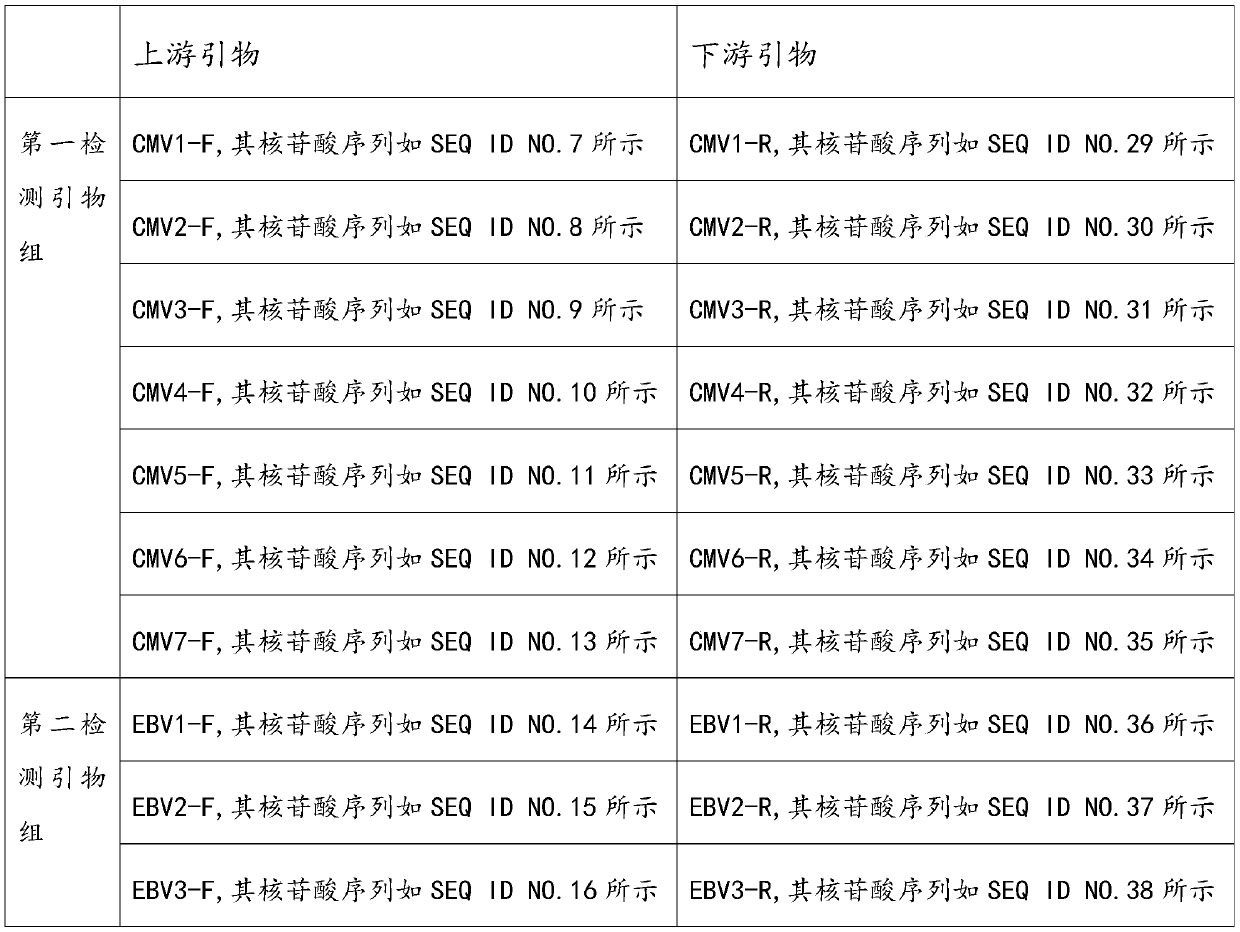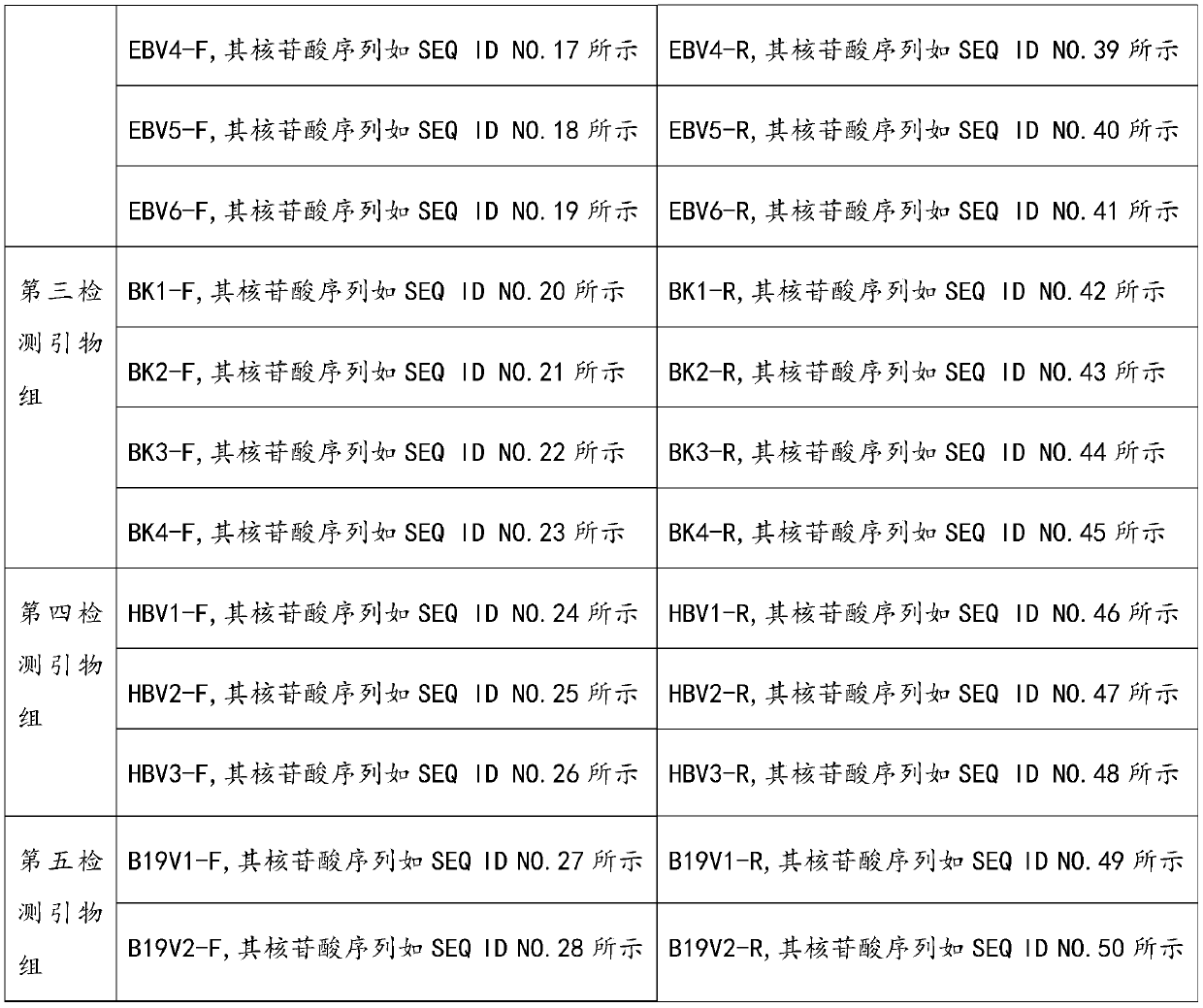Detection primer group, detection reagent and sequencing library for detecting organ transplantation postoperative infection
A technology for detecting primers and detection reagents, applied in the field of medical detection, can solve the problems of limited detection range of pathogens and low detection efficiency, and achieve the effects of improving survival rate and quality of life, reducing missed detection, and improving detection efficiency.
- Summary
- Abstract
- Description
- Claims
- Application Information
AI Technical Summary
Problems solved by technology
Method used
Image
Examples
Embodiment 1
[0051] This embodiment provides a detection primer set for detecting infection after organ transplantation, including a multiplex PCR primer set for CMV virus, EBV virus, BK virus, HBV virus and B19 virus, and a universal primer set. Wherein, the multiplex PCR primer set includes the first primer set for detecting CMV virus, the second primer set for detecting EBV virus, the third primer set for detecting BK virus, and the fourth primer set for detecting HBV virus , and a fifth primer set for detecting B19 virus.
[0052] The upstream primer of the multiplex PCR primer set has a first tag sequence at the 5' end and an upstream recognition sequence at the 3' end, and the downstream primer of the multiplex PCR primer set has a second tag sequence at the 5' end and a downstream recognition sequence at the 3' end. The nucleotide sequence of the first tag sequence is shown in SEQ ID NO.1, the nucleotide sequence of the second tag sequence is shown in SEQ ID NO.2, and the upstream r...
Embodiment 2
[0060] This embodiment provides a detection reagent for infection after organ transplantation, comprising the following components:
[0061] (1) Primer mixture I, comprising the multiplex PCR primer set that embodiment 1 provides, the upstream primer of multiplex PCR primer set and downstream primer mix with the molar ratio of 1: 1, make the concentration of each upstream primer and each downstream primer be 5 μM, the concentration of primer mixture I is 5 μM;
[0062] (2) Primer mixture II, comprising the universal primer set provided in Example 1, the upstream universal primer and the downstream universal primer of the universal primer set are mixed in a molar ratio of 1:1, so that the concentrations of the upstream universal primer and the downstream universal primer are both 5 μM, the concentration of primer mixture II is 5 μM;
[0063] (3) KAPA Hifi Enzyme Mix, KAPA Hifi Enzyme Mix contains DNA polymerase 0.5U / 25μL, MgCl 2 2.5mM, dATP 0.3mM, dCTP 0.3mM, dGTP 0.3mM and ...
Embodiment 3
[0065] This embodiment provides a method for constructing a sequencing library for detecting infection after organ transplantation, specifically, including the following steps:
[0066] S1, extract the genomic DNA or cell-free DNA of the sample to be tested
[0067] Use QIAGEN's DNA extraction kit (Cat. No.: 51304 / 55114) to extract genomic DNA or free DNA from the samples to be tested. The samples to be tested are blood samples or urine samples from patients undergoing organ transplantation. Patients undergoing organ transplantation are CMV virus and EBV. Virus, BK virus, HBV virus and B19 virus are all positively infected patients. The purity and concentration of the extracted DNA were determined using a fluorescence quantification instrument Qubit3.0, and the concentration of the extracted DNA was adjusted to 1-5 ng / μl.
[0068] S2, using the genomic DNA or free DNA extracted in step S1 as a DNA amplification template, using the detection primer set (22 upstream primers + 2...
PUM
 Login to View More
Login to View More Abstract
Description
Claims
Application Information
 Login to View More
Login to View More - R&D
- Intellectual Property
- Life Sciences
- Materials
- Tech Scout
- Unparalleled Data Quality
- Higher Quality Content
- 60% Fewer Hallucinations
Browse by: Latest US Patents, China's latest patents, Technical Efficacy Thesaurus, Application Domain, Technology Topic, Popular Technical Reports.
© 2025 PatSnap. All rights reserved.Legal|Privacy policy|Modern Slavery Act Transparency Statement|Sitemap|About US| Contact US: help@patsnap.com



